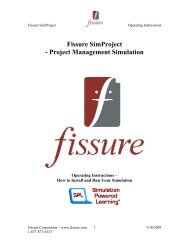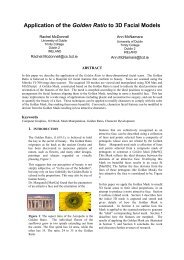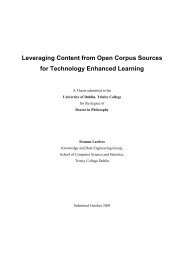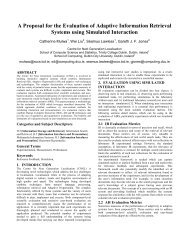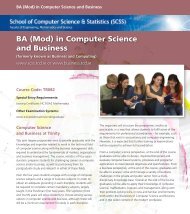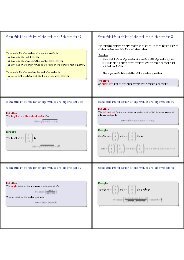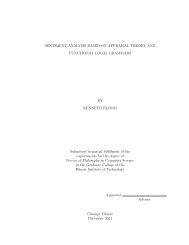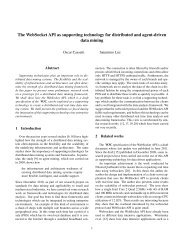Situations from events to proofs 1 Introduction
Situations from events to proofs 1 Introduction
Situations from events to proofs 1 Introduction
Create successful ePaper yourself
Turn your PDF publications into a flip-book with our unique Google optimized e-Paper software.
([BK03, FN05]). With ⇒, we can define the ϕ-bivalent language<br />
□ ⇒ ϕ + ϕ<br />
consisting of strings a 1 a 2 · · · a n ∈ Pow(Φ) ∗ such that for each i <strong>from</strong> 1 <strong>to</strong> n<br />
(inclusive), ϕ ∈ a i or ϕ ∈ a i . While we may want <strong>to</strong> work with strings that do<br />
not belong <strong>to</strong> this language (allowing a string <strong>to</strong> be silent on ϕ), it makes sense<br />
<strong>to</strong> restrict our <strong>events</strong> <strong>to</strong> strings in the ϕ-consistent language<br />
ϕ, ϕ ⇒ ∅<br />
requiring that no symbol in a string contain both ϕ and its negation ϕ. Similarly,<br />
<strong>to</strong> require that a fluent r occur at most once in a string, the constraint<br />
r □ ∗ r ⇒ ∅<br />
precludes the occurrence of r in two different positions in a string. We may<br />
impose this on r equal <strong>to</strong> some moment now or other.<br />
A Reichenbachian approach <strong>to</strong> tense and aspect locates the event time E<br />
relative <strong>to</strong> not only a speech time S but also a reference time R ([Rei47]). To<br />
see the point behind R, consider the pair (S2), (S3). (The oddness of (S3) is<br />
marked by the superscript ? .)<br />
(S2)<br />
(S3)<br />
Pat left Dublin but is back (in Dublin).<br />
? Pat has left Dublin but is back (in Dublin).<br />
In both (S2) and (S3), Pat’s departure L 0 <strong>from</strong> Dublin<br />
L 0<br />
def<br />
= L(Pat leave Dublin) ☎ in(p, d) □ ∗ in(p, d)<br />
(where the fluent in(p, d) is read Pat-in-Dublin) precedes the speech time S<br />
L(Pat left Dublin) ☎ L 0 □ ∗ S<br />
L(Pat has left Dublin) ☎ L 0 □ ∗ S .<br />
R allows us <strong>to</strong> distinguish L(Pat left Dublin) <strong>from</strong> L(Pat has left Dublin),<br />
coinciding with the end of L 0 in the former case<br />
and with S in the latter<br />
L(Pat left Dublin) ☎ in(p, d) □ ∗ in(p, d), R □ ∗ S (9)<br />
L(Pat has left Dublin) ☎ in(p, d) □ ∗ in(p, d) □ ∗ R, S . (10)<br />
In general, we apply aspectual and tense opera<strong>to</strong>rs in sequence, forming, for<br />
instance,<br />
L(Pat left Dublin) = Past(Simp(L 0 ))<br />
L(Pat has left Dublin) = Pres(Perf(L 0 ))<br />
13



